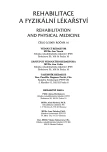-
Medical journals
- Career
Robotic Locomotion Therapy – First Experience in the Harmony Rehabilitation Center
Authors: S. Klobucká; E. Žiaková
Authors‘ workplace: Rehabilitačné centrum Harmony, Bratislava primár MUDr. S. Klobucká
Published in: Rehabil. fyz. Lék., 16, 2009, No. 3, pp. 126-134.
Category: Original Papers
Overview
A directed locomotion training results in supraspinal plasticity of motor centers of the CNS associated with locomotion functions. LOKOMAT is a new medical-technical device which continues in the manual-assisted training of gait by means of the treadmill. It fulfils the demanding criteria of present day neurorehabilitation based on the knowledge of plasticity of the central nervous system or the ability of reorganization and remodeling of the CNS activated by intensive stimulation from the periphery. Thanks to the precise control of the main parameters of gait stereotype and a significant facilitation of work with the patient suffering from walking disorder or disability the training may last longer, the therapy may be more effective and positive results may be reached at an earlier date. In the case report the authors describe improvement of motor functions, stability and ability to walk.
Key words:
Lokomat, poliomyelitis, locomotion training
Sources
1. BORGGRAEFE, I. et al.: Improved gait parameters after robotic - Assisted Locomotor treadmill therapy in a 6–year - Old child with cerebral palsy. Mov. Disord., 23, 2008, 2, s. 280-283.
2. DODD, K. J., FOLEY, S. : Partial body-weight-supported treadmill training can improve walking in children with cerebral palsy: A clinical controll trial. Dev. Med. Child Neurol., 49, 2007, 2, s. 101-105.
3. GROSS MOTOR FUNCTION MEASURE(GMFM): http://www.canchild.ca/Portals/0/outcoms/pdf/GMFMs coresheet.pdf.
4. GÚTH, A. A kol.: Vyšetrovacie metodiky v rehabilitácii pre fyzioterapeutov. Bratislava, LIEČREHGÚTH, 2003, s. 229, ISBN 80-88932-13-0.
5. HESSE, S.: Locomotor therapy in neurorehabilitation, NeuroRehabilitation, 16, 2001 s. 133-139.
6. HORNBY, T. G. et al.: Robotic assisted, body – Weight - supported treadmill training in individuals folloving motor incomplete spinal cord injury. Physical Therapy, 85, 2005, 1, s. 52-66.
7. KOLÁŘ, P.: Systematizace svalových dysbalancí z pohledu vývojové kineziolologie. Rehabil. fyz. Lék., 4, 2001, 4, s. 152-164.
8. MEYER – HEIM, A. et al.: Feasibility of robotic assisted locomotor trainig in children with central gait impairment. Dev. Med. Child. Neurol., 49, 2007, s. 900-906.
9. MEYER – HEIM, A., REIFFER, C., BORGGRAEFE, I.: Robot–assisted gait trainig for children with central motor disorders. Praxis Ergotherapie, Heft 1/2007, Verlag Modernes Lernen.
10. PFEIFFER, J.: Neurologie v rehabilitaci. 1. vyd., Praha, Grada Publishing, a.s., 2007, s. 352, ISBN 978 - 80-247-1135-5.
11. RUSSEL, D. J. et al.: Improved scaling of the Gross Motor Function Measure for children with cerebral palsy: Evidence of reliability and validity. Physical Therapy, 80, 2000, 9, s. 873-885.
12 TROJAN, S. a kol.: Lékařská fyziologie. 2. vyd., Praha, Grada Publishing, a.s., 1999, s. 554.
Labels
Physiotherapist, university degree Rehabilitation Sports medicine
Article was published inRehabilitation & Physical Medicine

2009 Issue 3-
All articles in this issue
- Therapeutic Solution of Lateral Instability of Astragalus Ligaments
- Conduction Velocity of Muscle Action Potential as an Indicator of Originating Muscular Fatigue in Surface Electromyography
- The Problem of Postoperative Stump in Patients with Transtibial Amputation as Viewed by Physiotherapist, Biomechanic and Prosthetic Specialists
- Electromyographical Analysis of Elastic Resistance Exercises on Trunk - a Case Study
- Postural Strategy in the Course of Motor Development
- Possible Compensation of Constitutive Hypermobility by Exercise in the Fitness Center
- Robotic Locomotion Therapy – First Experience in the Harmony Rehabilitation Center
- Rehabilitation & Physical Medicine
- Journal archive
- Current issue
- Online only
- About the journal
Most read in this issue- Postural Strategy in the Course of Motor Development
- The Problem of Postoperative Stump in Patients with Transtibial Amputation as Viewed by Physiotherapist, Biomechanic and Prosthetic Specialists
- Possible Compensation of Constitutive Hypermobility by Exercise in the Fitness Center
- Therapeutic Solution of Lateral Instability of Astragalus Ligaments
Login#ADS_BOTTOM_SCRIPTS#Forgotten passwordEnter the email address that you registered with. We will send you instructions on how to set a new password.
- Career

